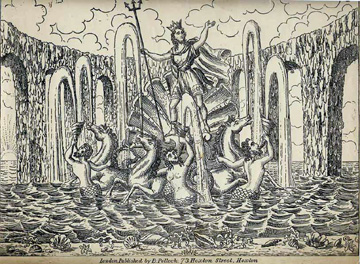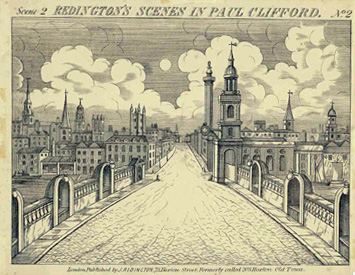A NOTE ON POLLOCK'S JUVENILE DRAMA
By
David Vaughan
copyright © 2004 by David Vaughan
 I
was intrigued by Mindy Aloff¹s recent item about Pollock’s
Toy Museum in London; my brother, Paul Vaughan, and I have been collectors
of the “penny plain, twopence coloured” toy theatre sheets
since we were boys. We were introduced to them by a family friend, whom
we called Uncle Cecil, though he was no relation, who built beautiful
model theatres and sets to go in them. For my tenth birthday, seventy
years ago, he took me to H.J. Webb’s shop in Old Street, where I
bought my first set of scenes and characters, for Robin Hood. That shop
closed soon afterward, but Benjamin Pollock’s shop in Hoxton continued
to sell plays published by him. It was the kind of shop that sold licorice
and bootlaces, hairpins and stationery, but in the back there were still
the lithograph stones from which the sheets were printed, and they were
still hand-painted by the Misses Pollock, the late Mr. Pollock’s
daughters, and sold at the same price of “a penny plain, and twopence
coloured.” In the 30s Paul and I would go to the shop and spend
our Christmas money on sheets for such plays as The Miller and his
Men (the most famous toy theatre play) and The Silver Palace.
That shop was destroyed in the Blitz.
I
was intrigued by Mindy Aloff¹s recent item about Pollock’s
Toy Museum in London; my brother, Paul Vaughan, and I have been collectors
of the “penny plain, twopence coloured” toy theatre sheets
since we were boys. We were introduced to them by a family friend, whom
we called Uncle Cecil, though he was no relation, who built beautiful
model theatres and sets to go in them. For my tenth birthday, seventy
years ago, he took me to H.J. Webb’s shop in Old Street, where I
bought my first set of scenes and characters, for Robin Hood. That shop
closed soon afterward, but Benjamin Pollock’s shop in Hoxton continued
to sell plays published by him. It was the kind of shop that sold licorice
and bootlaces, hairpins and stationery, but in the back there were still
the lithograph stones from which the sheets were printed, and they were
still hand-painted by the Misses Pollock, the late Mr. Pollock’s
daughters, and sold at the same price of “a penny plain, and twopence
coloured.” In the 30s Paul and I would go to the shop and spend
our Christmas money on sheets for such plays as The Miller and his
Men (the most famous toy theatre play) and The Silver Palace.
That shop was destroyed in the Blitz.
These prints were part of the fascination that theatres, large and small, have always had for me. One of my earliest memories is of a marionette theatre on the promenade at Ramsgate, a seaside resort near Margate, where our family spent summer holidays when I was a child. Then there were the “Pierrot shows” in fit-up theatres on the sands, and the Christmas pantomimes at the Brixton Theatre, near where we lived, and the Lyceum in the West End, which still (in the late 20s) had a Harlequinade at the end of the show. I still love to see the scene models displayed in the Orsay museum in Paris and at the back of the stalls at the Royal Opera House, Covent Garden.
At the Pollock’s shop I bought plain and coloured sheets, and at home painted the plain ones myself. I never actually produced a play on my toy theatre, an enterprise that Robert Louis Stevenson wrote entailed “long-drawn disenchantment” in his essay called, of course, “A Penny Plain and Twopence Coloured,” but my brother in later years entertained his own family with productions of The Miller and his Men and The Corsican Brothers.
 What
it is important to know is that these prints are a source of information
on theatrical history. The plays were all versions of current productions
on the London stage, and the artists who drew the characters and scenes
went to the theatres where they were being performed and made sketches
which were then used as the basis for the engraved sheets. So that the
attitudes struck by the characters, for instance, duplicate those taken
by real actors—in other words, they tell us something about 19th
century acting styles.
What
it is important to know is that these prints are a source of information
on theatrical history. The plays were all versions of current productions
on the London stage, and the artists who drew the characters and scenes
went to the theatres where they were being performed and made sketches
which were then used as the basis for the engraved sheets. So that the
attitudes struck by the characters, for instance, duplicate those taken
by real actors—in other words, they tell us something about 19th
century acting styles.
Of course, there is also a connection to 20th century ballet history. When Serge Diaghilev was preparing The Triumph of Neptune, a ballet with libretto by Sacheverell Sitwell, music by Lord Berners, and choreography by George Balanchine (first performed at none other than the Lyceum, in 1926), he visited the Webb and Pollock shops to select prints that were used as a basis for the scenery and costumes. (The costumes were designed by Pedro Pruna, but derived from toy theatre prints.)
I have continued to add to my own collection; for several years, I was able to buy sheets at the duplicate sales of the Performing Arts Library, especially those by the best of the Juvenile Drama publishers, William West, some of whose plays were engraved by no less an artist than George Cruikshank. Others were signed by the initials “W.B.,” sometimes thought to stand for William Blake. Today, in adddition to Pollock's Toy Museum, there is of course Pollock's Toy Shop in the Covent Garden Market, where one can buy reproductions of original Juvenile Drama plays and the theatres in which to mount them, as well as toy theatres from other countries such as Denmark, France, and Germany. On a recent visit to London, I found there a catalogue for an exhibition on William West and the Regency Toy Theatre, held earlier this year at Sir John Soane’s Museum in London and scheduled to tour other cities during 2004 and 2005. I intend to seek it out.
One other curious circumstance: in 1958 I was in the Broadway production of an early play by John Osborne (with Anthony Creighton), Epitaph for George Dillon. I played the small part of Mr. Webb, a social worker. In my preparations for this character, I decided that his name was H.J. Webb (the same initials as the Juvenile Drama publisher). A year or two later I played the same part in a summer stock tour of the play. In each theater, the apprentice assigned to finding props (who could not have known any of the details of my performance) would supply me with an attaché case. In one theater, there were initials on it: H.J.W
Notes illustrations
(both from the author's collection):
First: Pollock's Scenes in The Silver Palace, No.1, was
used for Act II Scene V: The Triumph of Neptune
Second: Redington's Scenes in Paul Clifford, No.2,
was used for Act I Scene 1 of The Triumph of Neptune: London
Bridge. (John Redington was an earlier publisher; Benjamin Pollock married
his daughter and took over his business.) .
Originally
published:
www.danceviewtimes.com
Volume 2, Number 19
May 24, 2004
Copyright
© 2004 by David Vaughan
|
|